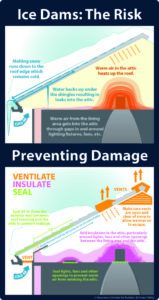B
Base flood elevation (BFE)
The elevation at which your building has a one percent chance of flooding annually. You can find the BFE for your property listed on many flood maps, especially newer ones. You can also contact your local building department or hire a licensed surveyor.
C
Combustible
Able to catch fire and burn. Combustible, flammable, and inflammable all have similar meanings.
D
Design pressure rating
The allowable wind pressure rating assigned to a window, door, or opening protection product, expressed as both a positive and negative pressure. The design pressure rating is based on specific testing and a required factor of safety.
Defensible space
An area around a building in which vegetation, debris, and other types of combustible fuels have been treated, cleared, or reduced to slow the spread of fire to and from the building.
This space is organized into three zones.
- Zone 1 (0–5 ft from the building) also called the home ignition zone, or noncombustible zone
- Zone 2 (5–30 ft or to the property line)
- Zone 3 (30–100 ft or to the property line)
Design wind speed
The wind speed specified in the building code for a given location that is used in accordance with code-accepted procedures to establish wind pressures and associated forces which a building or parts of a building must be capable of resisting.
E
Eave
The part of a roof that projects out from the side wall.
- Open eave: an eave that is not enclosed; the underside of the roof is visible from below.
- Boxed eave/soffited eave: an eave that is enclosed with a soffit.

F

Fire ratings for roofing materials
- Class A: Indicates roofing is able to withstand severe exposure to fire originating from sources outside the building. The highest fire-resistance rating for roofing as per ASTM E-108.
- Class B: Indicates roofing materials are able to withstand moderate exposure to fire originating from sources outside the building.
- Class C: Indicates roofing materials are able to withstand light exposure to fire originating from sources outside the building.
- Unrated: Indicates roofing materials do not pass requirements for Class C rating. These are the most vulnerable materials.
Flashing
Components used to weatherproof or seal roof system edges at perimeters, penetrations, walls, expansion joints, valleys, drains and other places where the roof covering is interrupted or terminated.
Flood map (floodplain map, FEMA flood map)
A map showing the floodplain location, flood zones, and Base Flood Elevation for each part of the community. The Federal Emergency Management Agency (FEMA) works with each municipality to create and update flood maps. Look up your property using the FEMA Flood Map Service Center. You may also contact your city or county government for more information. Your insurance agent or mortgage lender may also be able to assist.
Flood watch vs. flood warning
What is the difference between a Flood Watch and a Flood Warning issued by the National Weather Service?
- Flood Watch: Be Prepared: A Flood Watch is issued when conditions are favorable for a specific hazardous weather event to occur. A Flood Watch is issued when conditions are favorable for flooding. It does not mean flooding will occur, but it is possible.
- Flood Advisory: Be Aware: An Flood Advisory is issued when a specific weather event that is forecast to occur may become a nuisance. A Flood Advisory is issued when flooding is not expected to be bad enough to issue a warning. However, it may cause significant inconvenience, and if caution is not exercised, it could lead to situations that may threaten life and/or property.
- Flash Flood Warning: Take Action! A Flash Flood Warning is issued when a flash flood is imminent or occurring. If you are in a flood prone area move immediately to high ground. A flash flood is a sudden violent flood that can take from minutes to hours to develop. It is even possible to experience a flash flood in areas not immediately receiving rain.
- Flood Warning: Take Action! A Flood Warning is issued when the hazardous weather event is imminent or already happening. A Flood Warning is issued when flooding is imminent or occurring.
Source: https://www.weather.gov/safety/flood-watch-warning
Flood zones
Areas that FEMA has designated as low, moderate, or high according to levels of severity or type of flooding risk. The zones are shown on a community’s Flood Insurance Rate Map (FIRM) or Flood Hazard Boundary Map. Learn more at FEMA Flood Zone Designations.
Floodplain
An area of land susceptible to flooding.
H
Hail guards
Hail guards are specially designed protection systems that cover outdoor equipment components while allowing for adequate airflow.
While some hail guards are installed as part of a new equipment system, sometimes the hail guard is an optional feature that may be purchased at a later date for easy installation. It is also possible to retrofit existing equipment units. Depending on the manufacturer, hail guards can be UV protected, rot resistant, weather resistant, and abrasion and corrosion resistant.
Rooftop hail guards. Photos courtesy of Air Solution Company.
Hail-prone regions
I
Ice dam
Layers of ice that accumulate on the edges of a roof caused by snow accumulation and warm roof.
Ice dams form in cold weather when there is a layer of snow on the roof. Heat within the house rises into the attic and warms the roof. The snow on the roof melts a bit, and water runs under the snow down to the roof edge. The lower edge of the roof extends past the warm interior of the house it tends to be coldest. At the lower edge, a bit of the melt water refreezes under the snow and forms a thin layer of ice. When that happens again and again, the ice layer builds up and an ice dam is created. Over time, the ice dam expands to the point where it holds back a pool of water on the roof. The growth of the dam can force that water under the roof coverings such as shingles. From there, the water may find its way into the attic or down the walls of the house.
Impact-rated laminated window systems
To be impact rated, windows must meet American Society for Testing and Materials (ASTM) testing standards. Reputable window manufacturers and dealers should be able to provide appropriate documentation and labels that can be applied to window frames. The documentation will indicate the window is consistent with one of the following standards:
- ASTM E1886, E1996
- AAMA 506
- Florida Building Code TAS 201, 202, 203
- Miami-Dade County Product Control Approved and NOA number per TAS 201, 202, 203
Meeting any of the above test standards for the building- specific wind pressures should provide adequate protection in most high-wind situations. The International Building Code (IBC) references only the ASTM standards listed above. Contact a local window manufacturer or installer, or a design professional to assist with meeting the site-specific requirements and to ensure local municipal requirements are being met.
L
Lightning protection system
What is a lightning protection system and how does it work?
When a lightning protection grounding network is in place, a lightning strike is intercepted and directed to ground without impact to the structure, occupants or contents. The highly conductive copper and aluminum materials used in a lightning protection system provide a low resistance path to safely ground lightning’s dangerous electricity. A lightning protection system that meets national safety Standards of NFPA 780 and UL 96, UL 96A includes strike termination devices, down conductors, bonding, and surge protection. Failure to follow the Standards or use of non-listed materials or methods can result in inadequate protection.
Source: The Lightning Protection Institute, FAQ page
N
Noncombustible
Will not ignite and burn if exposed to fire. Noncombustible and incombustible have the same meaning.
R
Roof sheathing
The material that goes on top of the roofing structure (the trusses and beams), that the roofing cover is installed on. This is typically plywood or OSB.
S
Soffit
The exposed siding underneath your roof’s overhang.

Sump pump
A pump used to remove water that has accumulated in a water-collecting sump basin, commonly found in basements.
V
Vegetation Management Plan (VMP)
A plan (required in certain wildfire-prone areas) that provides important information about the land, such as:
- Topography (slope and aspect)
- Location of building(s) on the land
- Proposed fuel treatment details (suggested actions such as thinning and prescribed burning to minimize wildfire risks)
- Environmental concerns (threatened and endangered species, state-listed sensitive species and wetlands, etc.)
The VMP also provides detailed information on how the three defensible space zones will be developed and maintained. When developing a VMP, consult a landscape professional such as a forester, range manager, or natural resource specialist.
Vents
Designed openings in buildings that allow the circulation of air in enclosed portions of a home such as the attic and basement or crawl space.








